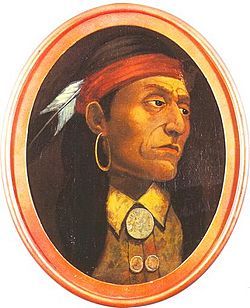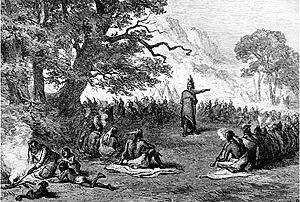Pontiac (Odawa leader) facts for kids
Quick facts for kids
Chief Pontiac
|
|
|---|---|
| Obwaandi'eyaag | |

No authentic visual depictions of Pontiac are known to exist. This interpretation was painted by John Mix Stanley.
|
|
| Born | c. 1714/20 Great Lakes region
|
| Died | April 20, 1769 (aged 48–55) near Cahokia, Illinois Country
|
| Cause of death | Assassination |
| Nationality | Odawa |
| Occupation | Regional speaker, Chieftain |
| Known for | Pontiac's War |
Pontiac or Obwaandi'eyaag (born around 1714–1720, died April 20, 1769) was an important Odawa leader. He is famous for his role in a major conflict called Pontiac's War, which lasted from 1763 to 1766. During this war, he led Native American groups in the Great Lakes region against the British. This struggle happened because many Native Americans were unhappy with British rules after the British won the French and Indian War.
The war began in May 1763 when Pontiac and about 300 followers tried to capture Fort Detroit by surprise. When his plan failed, Pontiac started a siege around the fort. Soon, over 900 warriors from different tribes joined him. News of Pontiac's actions spread, and the war grew much larger than just Detroit. In July 1763, Pontiac's forces won a battle against a British group at the Battle of Bloody Run. However, they could not take the fort. In October, Pontiac ended the siege and moved to the Illinois Country. His actions helped lead to the British government creating the Proclamation of 1763. This rule stopped settlers from moving west of the Appalachian Mountains, aiming to protect Native American lands.
Pontiac's influence around Detroit lessened after the siege. However, he became more respected as he continued to encourage other tribal leaders to fight the British. British officials wanted to end the war, so they focused their peace talks on Pontiac. In July 1766, he made peace with Sir William Johnson, a British official for Native American affairs. The British attention to Pontiac caused some other tribal leaders to feel resentful, as the war effort was not controlled by one person. Pontiac sometimes acted as if he had more power than he truly did. He became increasingly isolated and was killed by a Peoria warrior in 1769.
Contents
Pontiac's Early Life and Leadership
Very little is known about Pontiac's life before 1763. He was likely born between 1712 and 1725. His birthplace might have been an Odawa village near the Detroit River or Maumee River. Some records also suggest he was born in Defiance, Ohio. A park in Defiance, named Pontiac Park, marks this possible birthplace. Besides Pontiac, he was also known by his native name, Obwandiyag.
Historians are not completely sure about his parents' tribal backgrounds. An old Odawa story says his mother was Chippewa and his father was Odawa. However, some sources suggest one parent might have been Miami. Pontiac was always known as an Odawa by those who knew him. He lived close to Fort Detroit from about 1723, a fort he would later try to capture.
By 1747, Pontiac was already a war leader among the Odawa. He allied with New France against a resistance movement led by a Huron chief named Nicholas Orontony. Pontiac continued to support the French during the French and Indian War (1754–1763). This war was fought against British colonists and their Native American allies. He might have been part of a famous French and Native American victory in 1755, but there is no direct proof.
One of the first stories about Pontiac comes from Robert Rogers, a well-known British soldier. Rogers claimed to have met Pontiac in 1760, though some details of his story are not reliable. Rogers later wrote a play about Pontiac, which helped make the Odawa leader famous. This play started to create many legends about him.
Pontiac's War: Fighting for Native American Lands
The French and Indian War ended in 1760 when the British took control of Quebec. This meant the defeat of New France. Native American allies of the French soon became unhappy with how the British traded. The British also changed their policies towards Native Americans. They stopped giving gifts, which the French had always done. General Jeffery Amherst, a British leader, saw these gifts as bribes. He also limited the gunpowder and ammunition that Native Americans needed for hunting. Many Native Americans believed the British wanted to control or even destroy them.
After the war, British settlers began moving into areas that the French had once claimed. By 1761, Native American leaders started calling for tribes to unite. They wanted to drive the British out and bring back the alliance with the French. The French government, however, knew that the Great Lakes region was now under British control. Pontiac strongly wished for the French to return. He even thought that news of the French defeat was a British trick. A religious movement also fueled anti-British feelings. A Lenape prophet named Neolin urged Native Americans to reject European ways and return to their own traditions. Pontiac likely took part in a 1762 meeting where leaders called for tribes to prepare for war.
On April 27, 1763, Pontiac held a large meeting near Fort Detroit. He encouraged everyone to join him in a surprise attack on the fort. A few days later, on May 1, Pontiac visited the fort with 50 Odawa warriors. He wanted to see how strong the British defenses were.
At another meeting, Pontiac spoke about the British. He said they were different from the French, who had treated Native Americans as friends. He urged his people to unite and fight against the British. He believed they could win because the British soldiers were few in number.
Pontiac's War officially began on May 7, 1763. Pontiac and 300 followers tried to capture Fort Detroit by surprise. But Major Henry Gladwin, the fort's commander, had been warned. He was ready for the attack. Pontiac then started a siege of the fort. Soon, over 900 warriors from different tribes joined him. As Pontiac besieged Fort Detroit, messengers spread news of his actions. Native Americans launched widespread attacks against British forts and settlements. They took control of nine out of eleven British forts in the Ohio Valley. They also destroyed Fort Sandusky. In July 1763, Pontiac's forces defeated a British group at the Battle of Bloody Run. However, they could not capture Fort Detroit. In October, Pontiac ended the siege and moved to the Illinois Country, where some of his relatives lived.
Pontiac continued to encourage resistance against the British. He tried to get the Illinois and Wabash tribes, and even French colonists, to join him. Historians say that during this time, Pontiac became a very important regional leader. Even after the siege of Fort Detroit failed, Pontiac's influence continued to grow. The British realized they needed to negotiate with him. They made Pontiac the main focus of their peace efforts. On July 25, 1766, Pontiac met with Sir William Johnson, the British Superintendent of Indian Affairs. They signed a peace treaty at Fort Ontario in Oswego, New York, officially ending the fighting.
To prevent future uprisings, the British increased their military presence in the frontier after Pontiac's War. This outcome was actually the opposite of what Pontiac had hoped for. However, Pontiac's War was one of the last major Native American rebellions against British control in the Ohio Country. It happened before the United States was formed, which later led to a permanent white presence in the interior of North America.
Pontiac's Later Years and Death
Not much is known about Pontiac's last years. The attention he received from the British Crown encouraged him to act with more authority than was traditional for a Native American leader. By 1766, he was seen as acting very proudly and bossily. In 1768, he had to leave his Odawa village on the Maumee River. He moved to an area near Ouiatenon on the Wabash River. In a letter to British officials in May 1768, he explained that the people of his old village no longer recognized him as a chief.
Pontiac's Death
Pontiac was killed on April 20, 1769, near the French town of Cahokia. Most stories say he was killed in Cahokia, but some historians believe it happened in a nearby Native American village. His killer was a Peoria warrior whose name is not known.
Many rumors spread quickly about Pontiac's death. One rumor suggested the British had paid to kill him. Pontiac's burial place is unknown. He may have been buried in Cahokia. However, some evidence and traditions suggest his body was taken across the river and buried in St. Louis. This city had recently been founded by French colonists. In 1900, the Daughters of the American Revolution placed a plaque in St. Louis to honor Pontiac. It is located near where he was believed to be buried.
Pontiac's Legacy and Honors
Historians have different ideas about how important Pontiac truly was. Older stories often described him as a brilliant leader who planned a huge "conspiracy." For example, some called him the "Red Napoleon." Today, historians generally agree that Pontiac's actions at Detroit sparked the widespread uprising. They also agree that he helped spread the resistance by sending messages to other leaders. However, he did not command all the different tribal war leaders. These leaders often acted independently.
For example, tribal leaders near Fort Pitt and Fort Niagara had already been calling for war against the British. They were not led by Pontiac. Historian John Sugden noted that Pontiac "was neither the originator nor the strategist of the rebellion." But he started it by taking action. His early successes, ambition, and determination made him a very important Native American leader for a time. The British often thought that chiefs had more power than they actually did. They did not understand that Native American bands and tribes were often organized in a decentralized way.
Many places are named after Pontiac. These include the cities of Pontiac in Michigan and Illinois in the United States. There is also Pontiac, Quebec, in Canada, and the Pontiac Regional County Municipality in Quebec. Pontiac was also the name of a popular car brand from General Motors. This brand was based in Detroit and was discontinued in 2010. A Belgian watch company was also named after him. Many streets and buildings across the U.S. also bear Pontiac's name.




